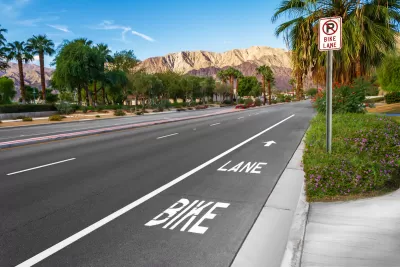Often car-centric, these cities in the South and West are working to make their roads safer for pedestrians, cyclists, and transit riders.

As their populations—and the number of pedestrian deaths—grow, Sun Belt cities Jacksonville Tucson and Memphis are rethinking their transportation planning strategies to improve safety and mobility for their residents. An article by Dan Zukowski, Julia Himmel, and Shaun Lucas in Smart Cities Dive reveals that “Nine of the 10 most dangerous states for pedestrians are in the Sun Belt, according to a 2022 Smart Growth America report.”
The article describes the road safety efforts that three cities—Tucson, Jacksonville, and Los Angeles. In Tucson, “The city is now looking to introduce ‘road diets’ with bikeways and safer crossings, thus reducing and slowing traffic for a ‘better pedestrian experience on those roadways as well as reducing vehicular crashes,’” according to its Complete Streets program coordinator.
In car-centric Jacksonville, “The [Jacksonville Transportation Authority] is working with the city of Jacksonville, the North Florida Transportation Planning Organization and the Florida Department of Transportation to focus road construction more on people and less on automobiles as they build additional roadways” by improving pedestrian and bike infrastructure along transit corridors, among other projects.
In Los Angeles, where half of the county’s fatal and severe-injury crashes occur on 4 percent of roads, “DPW is implementing tactics to improve pedestrian safety that include curb extensions to slow vehicles making right turns, high-visibility crosswalks and traffic signals that give pedestrians extra time.” Thanks to new flexibility created by a state law that allows cities to adjust speed limits for safety, Los Angeles lowered speed limits on 177 miles of road in 2022.
FULL STORY: Can Sun Belt cities go from danger zones to pedestrian-friendly?

Alabama: Trump Terminates Settlements for Black Communities Harmed By Raw Sewage
Trump deemed the landmark civil rights agreement “illegal DEI and environmental justice policy.”

Planetizen Federal Action Tracker
A weekly monitor of how Trump’s orders and actions are impacting planners and planning in America.

The 120 Year Old Tiny Home Villages That Sheltered San Francisco’s Earthquake Refugees
More than a century ago, San Francisco mobilized to house thousands of residents displaced by the 1906 earthquake. Could their strategy offer a model for the present?

LA’s Tree Emergency Goes Beyond Vandalism
After a vandal destroyed dozens of downtown LA trees, Mayor Karen Bass vowed to replace them. Days later, she slashed the city’s tree budget.

Sacramento Leads Nation With Bus-Mounted Bike Lane Enforcement Cameras
The city is the first to use its bus-mounted traffic enforcement system to cite drivers who park or drive in bike lanes.

Seattle Voters Approve Social Housing Referendum
Voters approved a corporate tax to fund the city’s housing authority despite an opposition campaign funded by Amazon and Microsoft.
Urban Design for Planners 1: Software Tools
This six-course series explores essential urban design concepts using open source software and equips planners with the tools they need to participate fully in the urban design process.
Planning for Universal Design
Learn the tools for implementing Universal Design in planning regulations.
Ada County Highway District
Clanton & Associates, Inc.
Jessamine County Fiscal Court
Institute for Housing and Urban Development Studies (IHS)
City of Grandview
Harvard GSD Executive Education
Toledo-Lucas County Plan Commissions
Salt Lake City
NYU Wagner Graduate School of Public Service





























